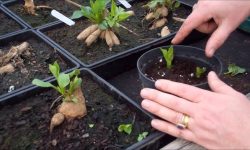Peonies are one of the most beloved flowering plants for gardeners worldwide. Their large, fragrant blooms and lush foliage bring elegance and charm to any garden space. While many gardeners prefer to buy established peony plants or divisions, growing peonies from seed offers a rewarding and cost-effective way to cultivate these stunning flowers. However, the process requires patience and careful attention to detail.
This comprehensive guide will walk you through how to plant peonies from seed, providing you with the knowledge to successfully nurture your own peony plants from the very beginning.
Understanding Peonies and Their Growing Habits

Before diving into the seed planting process, it’s important to understand some basic facts about peonies. Peonies are perennial plants that thrive in temperate climates. They are well-known for their longevity; some plants can live and bloom beautifully for decades. There are different types of peonies, such as herbaceous peonies, tree peonies, and intersectional (Itoh) peonies, each with slightly varying characteristics and care requirements.
When grown from seed, peonies take several years before they flower. This is a key point to keep in mind, as patience is essential for gardeners choosing this propagation method. Seeds generally need a long period of cold stratification to break dormancy, mimicking natural winter conditions.
Why Grow Peonies from Seed?
Growing peonies from seed allows gardeners to experiment with unique plant varieties and potentially create new cultivars. Unlike buying potted plants or divisions, seed propagation can be more affordable, especially if you have access to fresh seeds. Additionally, it gives a deeper appreciation for the plant’s life cycle and development.
That said, growing from seed is not the fastest way to get blooms. It can take anywhere from three to five years or more before the plants mature enough to flower. But for those willing to wait, the reward is seeing a peony grow from a tiny seed into a magnificent flowering shrub.
When to Collect and Plant Peony Seeds
Timing is crucial when collecting and planting peony seeds. Peony seed pods mature in late summer to early fall, usually around August to September depending on your local climate. Once the pods begin to dry and crack open, the seeds inside are ready to be harvested.
Collecting seeds at the right time is important. If you wait too long, the seeds may fall to the ground or lose viability. Fresh seeds have a better chance of germinating successfully. After collecting, it’s best to start the planting process promptly, or store the seeds in a cool, dry place until you’re ready.
Preparing Peony Seeds for Planting
Peony seeds have a hard outer coating and undergo a natural dormancy that requires a period of cold stratification to germinate. Simply planting fresh seeds in warm soil will not result in successful growth.
To prepare the seeds, you need to simulate winter conditions. This process is called stratification. The seeds should be kept moist and chilled for several weeks or even months. This can be done by placing the seeds in a sealed plastic bag with a moist medium like peat moss or sand, then refrigerating them at a temperature of around 1 to 5 degrees Celsius (34 to 41 degrees Fahrenheit).
Stratification typically lasts from 8 to 12 weeks, depending on the seed’s condition and the specific peony variety. Some gardeners opt to stratify for longer to improve germination rates. This cold period tricks the seed into “waking up,” preparing it to sprout when placed in warmer conditions.
How to Plant Peonies from Seed Outdoors
Planting peony seeds outdoors mimics the natural growth cycle and is a common method for gardeners with suitable climates. After stratification, the seeds are ready for sowing.
Choose a well-draining garden bed that receives plenty of sunlight, ideally six hours or more daily. Peonies do not like soggy soil, so soil with good drainage is vital to prevent root rot. Before planting, loosen the soil to a depth of at least 12 inches to encourage root development.
Plant the seeds about one inch deep in the soil, spacing them at least 12 inches apart to give them room to grow. Water the area gently but thoroughly to settle the soil around the seeds. It’s essential to keep the soil consistently moist but not waterlogged during the germination period.
One important note is that peony seeds often require a second winter period outdoors to break dormancy fully. This means the seeds might not germinate until the following spring after sowing. This natural delay is normal, and gardeners should be patient.
How to Plant Peonies from Seed Indoors
For gardeners in colder or unpredictable climates, starting peony seeds indoors offers more control over growing conditions and can protect young seedlings from harsh weather.
Begin by stratifying the seeds as described earlier. After the cold treatment, sow the seeds in pots or seed trays filled with a high-quality, well-draining potting mix. Plant each seed about one inch deep. It’s best to use containers with drainage holes to avoid waterlogging.
Place the containers in a bright area that receives indirect sunlight, maintaining a temperature around 65 to 70 degrees Fahrenheit (18 to 21 degrees Celsius). Water the soil to keep it moist but avoid saturation.
Seedlings may take several weeks to emerge. Once the seedlings develop a few sets of true leaves, they can be transplanted into larger pots to encourage stronger root systems. After a full growing season indoors, seedlings can be hardened off gradually by exposing them to outdoor conditions before planting them permanently in the garden.
Caring for Peony Seedlings
Young peony plants need consistent care to thrive. Whether started indoors or outdoors, keeping the soil evenly moist is essential but avoid overwatering, which can lead to fungal diseases or root rot.
Peonies prefer fertile, well-drained soil rich in organic matter. Adding compost or aged manure before planting can improve soil quality. During the growing season, a balanced fertilizer applied sparingly can support healthy growth, but avoid excessive nitrogen, which can lead to lush foliage but fewer flowers.
Sunlight is critical. Peonies grow best in full sun, although they can tolerate partial shade. Insufficient light can result in weak plants and poor flowering. If grown indoors, placing seedlings near a south-facing window or using supplemental grow lights helps ensure adequate light.
Regularly check seedlings for pests such as aphids or fungal infections, treating problems early with organic or chemical controls. Mulching around seedlings helps conserve moisture and suppress weeds, creating a favorable environment for root development.
Transplanting Peony Seedlings to Their Permanent Location
After growing strong seedlings for at least one full season, it’s time to move them to their permanent garden spot. This usually happens after the last frost in spring or early fall, depending on your region.
Choose a location with well-drained soil and full sun exposure. Carefully dig a hole twice as wide as the root ball but only as deep as the root system to avoid planting too deep. Peonies prefer to have their crown planted shallowly, just a couple of inches below the soil surface, to encourage healthy growth and flowering.
Gently remove seedlings from pots, being careful not to damage roots. Place the seedling in the hole, backfill with soil, and water thoroughly to settle the soil. Adding mulch helps retain moisture and protect young plants during establishment.
After transplanting, continue to provide consistent moisture and monitor the seedlings for stress or pest problems. Peonies may not bloom the first year after transplanting but should grow steadily.
Patience and Long-Term Care for Peonies from Seed
Growing peonies from seed requires patience, as it can take several years for plants to mature and produce flowers. During this time, providing consistent care will help the plants build strong root systems and healthy foliage.
Each year, apply a layer of compost or organic mulch to enrich the soil. Avoid disturbing the root zone too often. Peonies generally do not like to be moved once established, so choose their permanent location carefully.
In colder regions, peonies benefit from winter protection with mulch or straw to prevent freeze-thaw damage. In warmer areas, good air circulation helps prevent fungal diseases.
When your peony plants finally bloom, you’ll be rewarded with spectacular flowers that reflect your dedication and care. Growing from seed offers a unique gardening journey that deepens your connection to this classic garden favorite.
Troubleshooting Common Issues When Growing Peonies from Seed
Even with careful planting and care, challenges can arise. Poor germination is a frequent issue, often due to inadequate stratification or planting seeds that are too old or damaged. Ensuring seeds are fresh and properly cold-treated improves success.
Seedlings can succumb to damping-off, a fungal disease caused by overly wet conditions and poor air circulation. To prevent this, use sterile potting mix, avoid overwatering, and ensure good ventilation.
Pests such as aphids or fungal infections can weaken young plants. Early detection and treatment with appropriate methods help maintain plant health.
Lastly, environmental stress from extreme heat, drought, or frost damage can stunt growth. Providing shade during heatwaves and protecting seedlings from late frosts is beneficial.
FAQ about How to Plant Peonies from Seed
How long does it take for peonies grown from seed to bloom?
Peonies grown from seed typically take between three to five years to develop and produce their first flowers.
Do peony seeds need cold stratification before planting?
Yes, peony seeds require a cold stratification period of 8 to 12 weeks to break dormancy and improve germination rates.
Can I plant peony seeds directly outdoors?
You can plant peony seeds outdoors after stratification, but expect a slow germination process that might take up to two years.
What type of soil is best for growing peonies from seed?
Peonies prefer well-drained, fertile soil rich in organic matter to support healthy root development and growth.
How deep should I plant peony seeds?
Plant peony seeds about one inch deep in loose, well-prepared soil to encourage strong root growth.
Can I start peony seeds indoors?
Yes, starting peony seeds indoors after stratification helps control temperature and moisture for better seedling growth.
How do I care for peony seedlings after germination?
Keep the soil moist but not waterlogged, provide plenty of sunlight, and protect seedlings from pests and extreme weather.
Final Thoughts on How to Plant Peonies from Seed
Planting peonies from seed is a rewarding but long-term gardening project. It requires patience, careful preparation, and consistent care. By understanding the seed’s dormancy needs, providing proper stratification, and planting in suitable conditions, gardeners can successfully grow healthy peony plants from seed.
The process deepens appreciation for these elegant flowers and allows for the possibility of growing unique or rare varieties. With dedication, your efforts will bloom into breathtaking peony plants that enhance your garden’s beauty for years to come.






